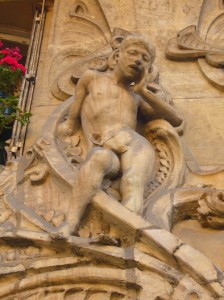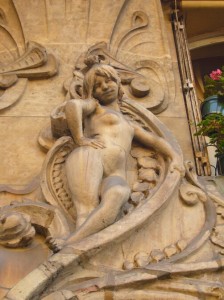
29 Avenue Rapp
Sebastien writes:
If the ideal of womanhood is to be wife, mother and homemaker, feminism will strip away all these gifts from her and all that will remain is her sexual appeal. So while feminists claim that women have been sexual objects and need to be free, the truth is that women become sexual objects because of feminist ideology. If they are not going to becomes wives and homemakers, other than sex, there is little else they can do as women. Of course few men would tell her that this is the path to despair because to do so would shut off the tap of easy sex. He therefore also becomes a slave to his sexual desires. So the fantasy of female liberty is dangled in front of men and women and both are enslaved by this.
Of course feminism didn’t start in the 60s, as was mentioned in a previous entry, many manifestations of this ideology existed well before this time. In 1901, the architect Jules Lavirotte won the Façade of the Year prize for his building at 29 Avenue Rapp in the 7th arrondissement in Paris. The building entrance is a monument to the triumph of female over the male through her sexuality. The doorway itself is a huge phallus. The sculpture that surrounds the entrance is a glimpse into a chaotic world where a despairing Adam and triumphant Eve have long lost their flush of innocence. What Lavirotte missed is that both Adam and Eve suffer. Eve just doesn’t know it yet.


I got to thinking about the feminine ideal as it existed in 1900 Paris after seeing this building. Just around the corner you can find the Parisian headquarters of the Theosophical Society, the internationalist organisation started by Elena Blavatsky, a New York socialite of the late 19th century. It seems that in the days of supposed Victorian rigour, women (at least the upper classes) were given a lot of freedom to impose their ideas in the public arena. This of course came with the approval and encouragement of men who were happy for many reasons. Many, I would imagine, enjoyed the easy access to sex that these attitudes permitted. A great many others glorified women simply for the joy they bring. Imagine a fusion between the Virgin Mary and the classical Venus and this I think, brought the ideal of woman to somewhere between goddess and plaything. Many woman could not resist being flattered by this.
The 1900 Universal Exposition in Paris was an explosion of creativity and science presented with all the elegance the Belle Epoque had to offer. The main entrance to the Exposition was the massive
Porte Binet on the Place de la Concorde. On top of this gateway was a six-metre high statue of La Parisienne. Almost every pavillion celebrated woman as muse and plaything. Personally, I admire the individuals who made this exposition possible and love to see women idealised in this way in the arts. What strikes me though is the total absence of Christianity except in the exhibit known as Vieux Paris, where you could find a gothic church.
Bear in mind that since the baptism of Clovis, the Kings of France adopted the fleur-de-lys, symbol of the Virgin Mary’s purity, in order to place France under her protection. Centuries later, the 15th of August (Assomption of the Virgin Mary) became a national holiday after Anne d’Autriche finally gave birth to a son, the future Louis XIV. The patron saint of Paris is Genevieve whose remains are in the wonderful St. Etienne-du-Mont Church near the Pantheon. The patron saint of France is Joan of Arc, regularly invoked in times of national distress. However, in 1900, in the pavillions of the Universal Exposition, the religious spirit of France is almost completely absent and, in the case of the Lavirotte building, the message of Adam and Eve is totally turned on its head.
Please follow and like us:



